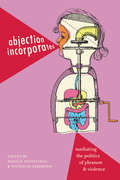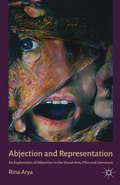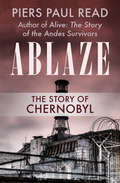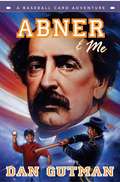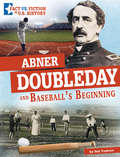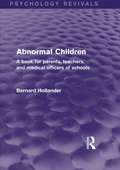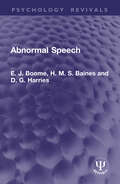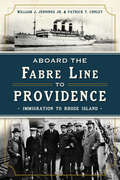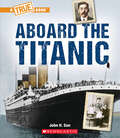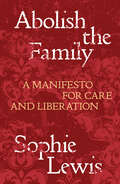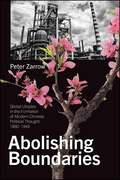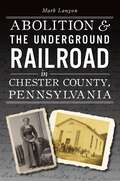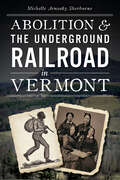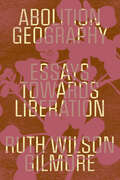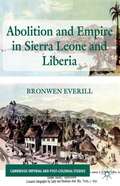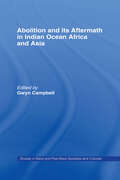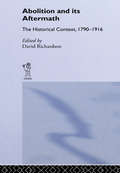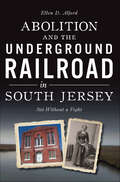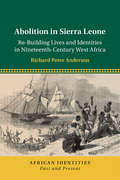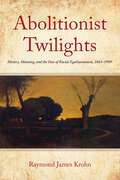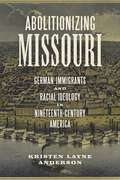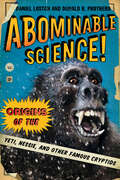- Table View
- List View
Abir Mukherjee 3 Books Collection Set: A Rising Man, A Necessary Evil & Smoke And Ashes
by Abir MukherjeeA Rising Man: India, 1919. Desperate for a fresh start, Captain Sam Wyndham arrives to take up an important post in Calcutta's police force. A Necessary Evil: Sam Wyndham is visiting the kingdom of Sambalpore, home to diamond mines and the beautiful Palace of the Sun. Smoke And Ashes: When Sam is summoned to investigate a grisly murder, he is stunned at the sight of the body: he's seen this before. Last night, in a drug addled haze, he stumbled across a corpse with the same ritualistic injuries. It seems like there's a deranged killer on the loose.
Abjection Incorporated: Mediating the Politics of Pleasure and Violence
by Nicholas Sammond Maggie HennefeldFrom the films of Larry Clark to the feminist comedy of Amy Schumer to the fall of Louis C. K., comedic, graphic, and violent moments of abjection have permeated twentieth- and twenty-first-century social and political discourse. The contributors to Abjection Incorporated move beyond simple critiques of abjection as a punitive form of social death, illustrating how it has become a contested mode of political and cultural capital—empowering for some but oppressive for others. Escaping abjection's usual confines of psychoanalysis and aesthetic modernism, core to theories of abjection by thinkers such as Kristeva and Bataille, the contributors examine a range of media, including literature, photography, film, television, talking dolls, comics, and manga. Whether analyzing how comedic abjection can help mobilize feminist politics or how expressions of abjection inflect class, race, and gender hierarchies, the contributors demonstrate the importance of competing uses of abjection to contemporary society and politics. They emphasize abjection's role in circumscribing the boundaries of the human and how the threats abjection poses to the self and other, far from simply negative, open up possibilities for radically new politics.Contributors. Meredith Bak, Eugenie Brinkema, James Leo Cahill, Michelle Cho, Maggie Hennefeld, Rob King, Thomas Lamarre, Sylvère Lotringer, Rijuta Mehta, Mark Mulroney, Nicholas Sammond, Yiman Wang, Rebecca Wanzo
Abjection and Representation: An Exploration of Abjection in the Visual Arts, Film and Literature
by R. AryaAbjection and Representation is a theoretical investigation of the concept of abjection as expounded by Julia Kristeva in Powers of Horror (1982) and its application in various fields including the visual arts, film and literature. It examines the complexity of the concept and its significance as a cultural category.
Ablaze: The Story of Chernobyl
by Piers Paul ReadA riveting account of the chilling precursors and deadly aftermath of the 1986 Soviet nuclear disaster from the bestselling author of Alive. This highly readable and deeply researched exposé draws upon unclassified data from the former Soviet Union and a wealth of firsthand interviews to give a complex and human account of one of the worst nuclear catastrophes in history. Starting in 1942, when a young Russian physicist named Georgi Flerov warned Stalin that the Americans were building an atomic bomb, author Piers Paul Read recounts the birth and growth of atomic energy in the USSR—and the construction of the V. I. Lenin Nuclear Power Station at Chernobyl. Embedded in this story are the KGB cover-ups, power grabs, safety oversights, and risky decisions that set the stage for the explosion of the station&’s fourth reactor on April 26, 1986. According to Soviet authorities, only thirty-one people lost their lives due to the Chernobyl disaster, but its consequences were far too big for even the Kremlin to sweep under the rug—though the authorities certainly tried. Radiation burns and nuclear debris could not be concealed, and the cloud of radioactive material spewing from the damaged reactor was monitored throughout Europe. In the areas most immediately affected, there was a leap in the incidence of thyroid cancer. Moment by moment, Read takes us through the chaos and horror of the meltdown, and voice by voice, he records the stories that reveal the lasting repercussions of that day. Set in a regime where demotion was considered a fate worse than death and silence had the power to kill, Ablaze tackles the social and technological chain reactions that wreaked havoc not only on the USSR&’s power supply but on the strength and stability of the nation. It is a must-read for anyone interested in Soviet-era history or the promises and perils of nuclear power.
Abner & Me
by Dan GutmanCannons are blasting! Bullets are flying! Wounded soldiers are everywhere! Stosh has time-traveled to 1863, right into the middle of the Civil War. In possibly his most exciting and definitely his most dangerous trip yet, Stosh has decided to answer the question for all time: did Abner Doubleday, a Civil War general, really invent the game of baseball? It's all here: big laughs, dramatic action, fast baseball games in the middle of a battlefield. You'll be blown away by this sixth amazing baseball card adventure!
Abner Doubleday and Baseball's Beginning: Separating Fact from Fiction (Fact vs. Fiction in U.S. History)
by Nel YomtovStep up to the plate and separate fact from fiction in baseball’s origins! Did Abner Doubleday really create America’s favorite pastime, or does this story strike out? Learn all you can about baseball’s beginnings with infographics, primary sources, and expertly leveled text.
Abner Doubleday, Young Baseball Pioneer (Childhood of Famous Americans Series)
by Montrew DunhamAbner Doubleday was a young baseball player. His love for baseball, leadership skills, and great spirit, are motivations to the young. Abner Doubleday later become a second-in-command Captain.
Abnormal Children: A Book for Parents, Teachers, and Medical Officers of Schools (Psychology Revivals)
by Bernard HollanderBorn in Vienna in 1864, Bernard Hollander was a London-based psychiatrist. He is best known for being one of the main proponents of phrenology. This title, originally published in 1916, deals with "the nervous defects of children, and the various forms and degrees of mental and moral deficiency that may occur from infancy up to the age of twenty-one." Very much of its time, it looks at both what it calls the "subnormal" and the "supernormal" child, the causes of abnormality, and suggests ways of educating children in order to minimise their defects and maximise their abilities. This is an opportunity to enjoy a historical look at child psychology from the early twentieth century.
Abnormal Speech (Psychology Revivals)
by E. J. Boome H. M. Baines D. G. HarriesOriginally published in 1939, it was only recently that serious study and attention had been given to disorders of speech and there was a growing demand for books dealing with the subject. Abnormal Speech deals concisely with the aetiology of the varied abnormalities of speech and discusses the treatment practised by experienced therapists at the time, successful in affecting permanent cures. It was now recognised that the causes and classification of speech disorders were fairly numerous, and that the essence of treatment consisted of discovering the nature and cause to apply the appropriate method of treatment. It was revised in 1950 in some part to account for the effects of the second world war on speech disorders.Today it can be read in its historical context.This book is a re-issue originally published in 1939. The language used and views portrayed are a reflection of its era and no offence is meant by the Publishers to any reader by this re-publication.
Aboard the Fabre Line to Providence: Immigration to Rhode Island
by Patrick T. Conley William J. Jennings Jr.In an era when immigration was at its peak, the Fabre Line offered the only transatlantic route to southern New England. One of its most important ports was in Providence, Rhode Island. Nearly eighty-four thousand immigrants were admitted to the country between the years 1911 and 1934. Almost one in nine of these individuals elected to settle in Rhode Island after landing in Providence, amounting to around eleven thousand new residents. Most of these immigrants were from Portugal and Italy, and the Fabre Line kept up a brisk and successful business. However, both the line and the families hoping for a new life faced major obstacles in the form of World War I, the immigration restriction laws of the 1920s, and the Great Depression. Join authors Patrick T. Conley and William J. Jennings Jr. as they chronicle the history of the Fabre Line and its role in bringing new residents to the Ocean State.
Aboard the Titanic (A True Book (Relaunch))
by John SonRediscover the story of the largest and most luxurious ship ever built!There were close to 2,200 people aboard the Titanic for its maiden voyage, including about 900 crew members. Among the ship's first-class passengers were some of the richest people in the world -- from business tycoons to movie stars. In second- and third-class compartments were people from across Europe who were sailing to a new life in America. Also aboard that April were Joseph Laroche, the only Black passenger on the Titanic, Masabumi Hosono, the only Japanese passenger, and a group of six Chinese men travelling in third class. Take a fateful trip with all these travelers in the pages of Aboard the Titanic.ABOUT THIS SERIES: On the night of April 14-15, 1912, the largest and most luxurious ship ever built hit an iceberg and sunk on her maiden voyage. More than 100 years later, the Titanic continues to fascinate. How did this supposedly "unsinkable" ship meet its icy fate? Who were the people who sailed on the ship, and what was that experience like before, during, and after the disaster? What did explorers discover in 1985 when they found the sunken ship at the bottom of the Atlantic Ocean? Featuring historical imagery, first-hand accounts, and lively text, the four titles in this series will answer all these questions… and more.
Abolish the Family: A Manifesto for Care and Liberation
by Sophie LewisWhat if we could do better than the family? We need to talk about the family. For those who are lucky, families can be filled with love and care, but for many they are sites of pain: from abandonment and neglect, to abuse and violence. Nobody is more likely to harm you than your family. Even in so-called happy families, the unpaid, unacknowledged work that it takes to raise children and care for each other is endless and exhausting. It could be otherwise: in this urgent, incisive polemic, leading feminist critic Sophie Lewis makes the case for family abolition. Abolish the Family traces the history of family abolitionist demands, beginning with nineteenth century utopian socialist and sex radical Charles Fourier, the Communist Manifesto and early-twentieth century Russian family abolitionist Alexandra Kollontai. Turning her attention to the 1960s, Lewis reminds us of the anti-family politics of radical feminists like Shulamith Firestone and the gay liberationists, a tradition she traces to the queer marxists bringing family abolition to the twenty-first century. This exhilarating essay looks at historic rightwing panic about Black families and the violent imposition of the family on indigenous communities, and insists: only by thinking beyond the family can we begin to imagine what might come after.
Abolishing Boundaries: Global Utopias in the Formation of Modern Chinese Political Thought, 1880–1940 (SUNY series in Chinese Philosophy and Culture)
by Peter ZarrowHonorable Mention, 2022 Sharon Harris Book Award presented by the University of Connecticut Humanities InstituteFocusing on four key Chinese intellectuals of the first half of the twentieth century, Abolishing Boundaries offers new perspectives on modern Chinese political thought. These four intellectuals—Kang Youwei, Cai Yuanpei, Chen Duxiu, and Hu Shi—were deeply familiar with the Confucian and Buddhist classical texts, while also interested in the West's utopian literature of the late nineteenth century as well as Kant and the neo-Kantians, Marxists, and John Dewey and new liberalism, respectively. Although none of these four intellectuals can simply be labeled utopian thinkers, this book highlights how their thinking was intertwined with utopian ideals to produce theories of secular transcendence, liberalism, and communism, and how, in explicit and implicit ways, their ideas required some utopian impulse in order to escape the boundaries they identified as imprisoning the Chinese people and all humanity. To abolish these boundaries was to imagine alternatives to the unbearable present. This was not a matter of armchair philosophizing but of thinking through new ways to commit to action. These men did not hold a totalistic picture of some perfect society, but in distinctly different ways they all displayed a utopian impulse that fueled radical visions of change. Their work reveals much about the underlying forces shaping modern thought in China—and the world. Reacting to China's problems, they sought a better future for all humanity.
Abolition & the Underground Railroad in Chester County, Pennsylvania (American Heritage)
by Mark LanyonChester County was home to a diverse patchwork of religious communities, antislavery activists and free Black populations, all working to end the blight of slavery during the Civil War era. Kennett Square was known as the "hotbed of abolitionism," with more Underground Railroad stations than anywhere else in the nation. Reverend John Miller Dickey and the Hinsonville community under the leadership of James Ralston Amos and Thomas Henry Amos founded the Ashmun Institute, later renamed Lincoln University, the nation's oldest degree-granting Historically Black College and University. The county's myriad Quaker communities fostered strong abolitionist sentiment and a robust pool of activists aiding runaway slaves on their road to emancipation. Author Mark Lanyon captures the rich history of antislavery activity that transformed Chester County into a vital region in the nation's fight for freedom.
Abolition & the Underground Railroad in Vermont (Civil War Ser.)
by Michelle Arnosky SherburneMany believe that support for the abolition of slavery was universally accepted in Vermont, but it was actually a fiercely divisive issue that rocked the Green Mountain State. In the midst of turbulence and violence, though, some brave Vermonters helped fight for the freedom of their enslaved Southern brethren. Thaddeus Stevens--one of abolition's most outspoken advocates--was a Vermont native. Delia Webster, the first woman arrested for aiding a fugitive slave, was also a Vermonter. The Rokeby house in Ferrisburgh was a busy Underground Railroad station for decades. Peacham's Oliver Johnson worked closely with William Lloyd Garrison during the abolition movement. Discover the stories of these and others in Vermont who risked their own lives to help more than four thousand slaves to freedom.
Abolition Geography: Essays Towards Liberation
by Ruth Wilson GilmoreThe first collection of writings from one of the foremost contemporary critical thinkers on racism, geography and incarcerationGathering together Ruth Wilson Gilmore&’s work from over three decades, Abolition Geography presents her singular contribution to the politics of abolition as theorist, researcher, and organizer, offering scholars and activists ways of seeing and doing to help navigate our turbulent present. Abolition Geography moves us away from explanations of mass incarceration and racist violence focused on uninterrupted histories of prejudice or the dull compulsion of neoliberal economics. Instead, Gilmore offers a geographical grasp of how contemporary racial capitalism operates through an &“anti-state state&” that answers crises with the organized abandonment of people and environments deemed surplus to requirement. Gilmore escapes one-dimensional conceptions of what liberation demands, who demands liberation, or what indeed is to be abolished. Drawing on the lessons of grassroots organizing and internationalist imaginaries, Abolition Geography undoes the identification of abolition with mere decarceration, and reminds us that freedom is not a mere principle but a place. Edited with an introduction by Brenna Bhandar and Alberto Toscano.
Abolition and Empire in Sierra Leone and Liberia
by Bronwen EverillBronwen Everill offers a new perspective on African global history, applying a comparative approach to freed slave settlers in Sierra Leone and Liberia to understand their role in the anti-slavery colonization movements of Britain and America.
Abolition and Its Aftermath in the Indian Ocean Africa and Asia
by Gwyn CampbellThis important collection of essays examines the history and impact of the abolition of the slave trade and slavery in the Indian Ocean World, a region stretching from Southern and Eastern Africa to the Middle East, India, Southeast Asia and the Far East. Slavery studies have traditionally concentrated on the Atlantic slave trade and slavery in the Americas. In comparison, the Indian Ocean World slave trade has been little explored, although it started some 3,500 years before the Atlantic slave trade and persists to the present day. This volume, which follows a collection of essays The Structure of Slavery in Indian Ocean Africa and Asia (Frank Cass, 2004), examines the various abolitionist impulses, indigenous and European, in the Indian Ocean World during the nineteenth and twentieth centuries. It assesses their efficacy within a context of a growing demand for labour resulting from an expanding international economy and European colonisation. The essays show that in applying definitions of slavery derived from the American model, European agents in the region failed to detect or deliberately ignored other forms of slavery, and as a result the abolitionist impulse was only partly successful with the slave trade still continuing today in many parts of the Indian Ocean World.
Abolition and Its Aftermath: The Historical Context 1790-1916
by David RichardsonFirst published in 1987. Routledge is an imprint of Taylor & Francis, an informa company.
Abolition and the Underground Railroad in South Jersey: Not Without a Fight (American Heritage)
by Ellen AlfordSouthern New Jersey was a hotbed of slave fugitives, freedmen and abolitionists in the Civil War era.The proud 22nd Regiment of the United States Colored Troops included hundreds of Black New Jerseyans ready to fight for emancipation and the Union cause. Abolitionists such as Harriet Tubman, Abigail Goodwin and Benjamin Sheppard operated among key landmarks of the Underground Railroad in South Jersey counties such as Cape May, Cumberland and Salem. Slavery and the rights of Black Americans were at the forefront of the region's attention including stories such as a melee in a Cape May hotel between Black waiters and white patrons, the covert signaling of boats ferrying fugitive slaves across the Delaware River and the daring rescue of a runway slave from the hands of slave catches by local church worshipers.Author Ellen Alford reveals the history of abolition and the Underground Railroad in South Jersey.
Abolition in Sierra Leone: Re-Building Lives and Identities in Nineteenth-Century West Africa (African Identities: Past and Present)
by Richard Peter AndersonTracing the lives and experiences of 100,000 Africans who landed in Sierra Leone having been taken off slave vessels by the British Navy following Britain's abolition of the trans-Atlantic slave trade, this study focuses on how people, forcibly removed from their homelands, packed on to slave ships, and settled in Sierra Leone were able to rebuild new lives, communities, and collective identities in an early British colony in West Africa. Their experience illuminates both African and African diaspora history by tracing the evolution of communities forged in the context of forced migration and the missionary encounter in a prototypical post-slavery colonial society. A new approach to the major historical field of British anti-slavery, studied not as a history of legal victories (abolitionism) but of enforcement and lived experience (abolition), Richard Peter Anderson reveals the linkages between emancipation, colonization, and identity formation in the Black Atlantic.
Abolitionist Twilights: History, Meaning, and the Fate of Racial Egalitarianism, 1865-1909 (Reconstructing America)
by Raymond James KrohnProvides unique insight into Reconstruction’s downfall and Jim Crow’s emergence.In the years and decades following the American Civil War, veteran abolitionists actively thought and wrote about the campaign to end enslavement immediately. This study explores the late-in-life reflections of several antislavery memorial and historical writers, evaluating the stable and shifting meanings of antebellum abolitionism amidst dramatic changes in postbellum race relations. By investigating veteran abolitionists as movement chroniclers and commemorators and situating their texts within various contexts, Raymond James Krohn further assesses the humanitarian commitments of activists who had valued themselves as the enslaved people’s steadfast friends.Never solely against slavery, post-1830 abolitionism challenged widely held anti-Black prejudices as well. Dedicated to emancipating the enslaved and elevating people of color, it equipped adherents with the necessary linguistic resources to wage a valiant, sustained philanthropic fight. Abolitionist Twilights focuses on how the status and condition of the freedpeople and their descendants affected book-length representations of antislavery persons and events. In probing veteran– abolitionist engagement in or disengagement from an ongoing African American freedom struggle, this ambitious volume ultimately problematizes scholarly understandings of abolitionism’s racial justice history and legacy.
Abolitionists Remember
by Julie Roy JeffreyIn Abolitionists Remember, Julie Roy Jeffrey illuminates a second, little-noted antislavery struggle as abolitionists in the postwar period attempted to counter the nation's growing inclination to forget why the war was fought, what slavery was really like, and why the abolitionist cause was so important. In the rush to mend fences after the Civil War, the memory of the past faded and turned romantic--slaves became quaint, owners kindly, and the war itself a noble struggle for the Union. Jeffrey examines the autobiographical writings of former abolitionists such as Laura Haviland, Frederick Douglass, Parker Pillsbury, and Samuel J. May, revealing that they wrote not only to counter the popular image of themselves as fanatics, but also to remind readers of the harsh reality of slavery and to advocate equal rights for African Americans in an era of growing racism, Jim Crow, and the Ku Klux Klan. These abolitionists, who went to great lengths to get their accounts published, challenged every important point of the reconciliation narrative, trying to salvage the nobility of their work for emancipation and African Americans and defending their own participation in the great events of their day.
Abolitionizing Missouri: German Immigrants and Racial Ideology in Nineteenth-Century America (Antislavery, Abolition, and the Atlantic World)
by Kristen Layne AndersonHistorians have long known that German immigrants provided much of the support for emancipation in southern Border States. Kristen Layne Anderson's Abolitionizing Missouri, however, is the first analysis of the reasons behind that opposition as well as the first exploration of the impact that the Civil War and emancipation had on German immigrants' ideas about race. Anderson focuses on the relationships between German immigrants and African Americans in St. Louis, Missouri, looking particularly at the ways in which German attitudes towards African Americans and the institution of slavery changed over time. Anderson suggests that although some German Americans deserved their reputation for racial egalitarianism, many others opposed slavery only when it served their own interests to do so. When slavery did not seem to affect their lives, they ignored it; once it began to threaten the stability of the country or their ability to get land, they opposed it. After slavery ended, most German immigrants accepted the American racial hierarchy enough to enjoy its benefits, and had little interest in helping tear it down, particularly when doing so angered their native-born white neighbors. Anderson's work counters prevailing interpretations in immigration and ethnic history, where until recently, scholars largely accepted that German immigrants were solidly antislavery. Instead, she uncovers a spectrum of Germans' "antislavery" positions and explores the array of individual motives driving such diverse responses. . In the end, Anderson demonstrates that Missouri Germans were more willing to undermine the racial hierarchy by questioning slavery than were most white Missourians, although after emancipation, many of them showed little interest in continuing to demolish the hierarchy that benefited them by fighting for black rights.
Abominable Science!: Origins of the Yeti, Nessie, and Other Famous Cryptids
by Donald R. Prothero Daniel Loxton&“A sharp analysis of the quest for unreal critters―cryptids, as they are called―and the people who pursue them . . . entertaining and thoroughly documented.&” —The Wall Street Journal Throughout our history, humans have been captivated by mythic beasts and legendary creatures. Tales of Bigfoot, the Yeti, and the Loch Ness monster are part of our collective experience. Now comes a book from two dedicated investigators that explores and elucidates the fascinating world of cryptozoology. Daniel Loxton and Donald R. Prothero have written an entertaining, educational, and definitive text on cryptids, presenting the arguments both for and against their existence and systematically challenging the pseudoscience that perpetuates their myths. After examining the nature of science and pseudoscience and their relation to cryptozoology, Loxton and Prothero take on Bigfoot; the Yeti, or Abominable Snowman, and its cross-cultural incarnations; the Loch Ness monster and its highly publicized sightings; the evolution of the Great Sea Serpent; and Mokele Mbembe, or the Congo dinosaur. They conclude with an analysis of the psychology behind the persistent belief in paranormal phenomena, identifying the major players in cryptozoology, discussing the character of its subculture, and considering the challenge it poses to clear and critical thinking in our increasingly complex world. &“As valuable for its analysis of the hunted as it is for the light it shines on the still-hopeful hunters.&” —Publishers Weekly &“Highly recommended for readers looking for scientific but accessible evaluations of the existence of five notable cryptids that have captured our imaginations.&” —Library Journal (starred review)

